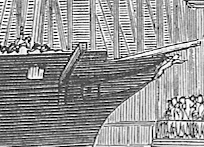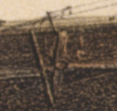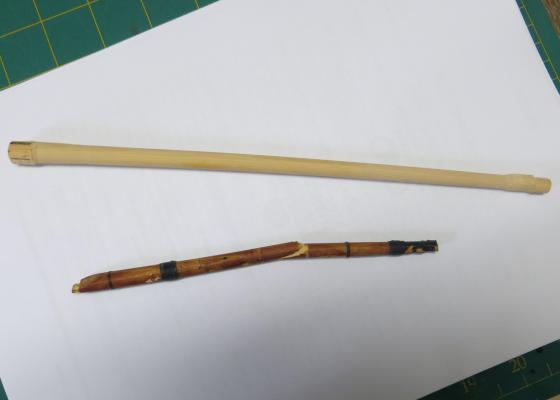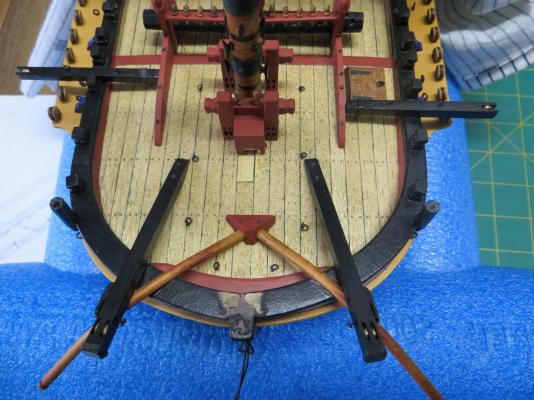-
Posts
5,951 -
Joined
-
Last visited
Content Type
Profiles
Forums
Gallery
Events
Everything posted by BANYAN
-
Hi Rod, the mahogany planks look fine mate. Will you be painting the silver ash (if they are silver ash, they look a bit like the cheap pale coloured veneer in the AL kits)? If you are, simply fill and sand, then paint. If not you need to decide whether you can live with them; if you can, a light sand may remove some of the pitting/chipping. I always bought more veneer than provided in the kit so that I could select the least chipped along the edge ones; sanding can be done on the edge to bevel it which can provide a tighter fit (I did that) but if not painting I run a 2b pencil along the edge to give definition. cheers Pat
- 33 replies
-
- perseverance
- modellers shipyard
-
(and 1 more)
Tagged with:
-

Cat Head dimensions
BANYAN replied to BANYAN's topic in Building, Framing, Planking and plating a ships hull and deck
Hi Mark, The attached show the cathead 1. At launch (from a woodcut etching in the London Illustrated News) and 2. the lithograph. I am unsure what the near vertical sloping long beam aft of the cathead is, as in the litho (not shown in the woodcut) the anchor stock is clearly evident as a separate part, but the ornamentation of the knee (I think) is evident in the litho. The knee is not shown in the woodcut, but there is a rebate where it was to be fitted? cheers Pat -

Cat Head dimensions
BANYAN replied to BANYAN's topic in Building, Framing, Planking and plating a ships hull and deck
Very many thanks Mark, appreciate the feedback, especially on the whiskers. As to the Cathead, last night I took the Arrow class drawings and used that as the basis for drawing Victoria's catheads. The basis of theoverall length question is that, according to Goodwin, the sheave slot length is 2 x sheave diameter. The sheave diameter is determine by 25/32 the breadth of the cathead ( which in this case I know to be 13" from the Contract records) - so 10.16" sheave diameter. The overall offset length of the cathead (so I am only considering the offset distance clear of the hull, not the overall length taking into account the cranked/canted upward slope) is 36 inches (enough to clear the anchor arm). However, by Goodwin's guidance etc, this means the overall length of 36 inches (from Arrow class), with the sheave slots ending about 13 inches from the end according to Goodwin, and each sheave slot being about 20.32" long. This would have the crown under the fish davit much further out, and the anchor shackle less than half way out along the cathead as you look down on it (all fits if the stock is canted along the sloping cathead - a la HMS Warrior - JUST!) but it sure does look strange having such long slots in such a relatively short cathead, and them being so close into the hull slots ends being just 3" out board, shackle being 13" outboard). Most other depictions of catheads I have seen do not have the slots anywhere near this big or this close to the hull. Hence the question I understand that the 20" slots would have been along the overall length which would look foreshortened in an overhead/plan view - but even so, they would still be close to the hull and looks very strange. Cheers, and thanks again for the input. Pat -

Cat Head dimensions
BANYAN replied to BANYAN's topic in Building, Framing, Planking and plating a ships hull and deck
Hi John, thanks for the feedback. I have some drawings of upward canted catheads as fitted in clippers, but only a photo of one in a warship. These are enough to create a best-guess design for the Victoria which I can use the width of the anchor arm as an indicative (or minimum) distance to place the tip from the hull. However, I was hoping there might be some guidance somewhere that naval architects may have used. if I cannot find anything more definitive I am going to use the plan view off-set distance shown for the Vigilant Class ships, but translate this to incorporate the upward cant. I am just hoping someone somewhere may have seen a rule-of-thumb or the like that stated something like anchor arm length x 1.22 or something for the off-set distance; the rest I could interpolate. I think I have tracked down almost all known drawings, lithographs, plans, photos etc of this ship and yep, a great pity the Government, Navy or other authority did not keep any significant records etc. it is almost like they washed their hands of the Victorian Colonial Navy There is only one painting that I am aware of that I do not have a copy of. I have managed to purchase copies of all known photographs, wood cut etching (London Illustrated News) and lithographs etc. The owner of the only known surviving/existing plan for the ship (single sheet as drawn by Lang and include the side profile, sheer and waterlines, and a separate drawing of the boilers) has kindly let us take a copy in return for the model to go on display in his Museum when it is completed. The other known set of plans have disappeared from the Victorian Records Office (and no, the set discussed earlier are not those ). I have also assembled every newspaper article, journal articles, magazine articles I can find, and a copy of the Geoffrey Ingleton documents, etc etc. I have also engaged a researcher in the UK whom has tracked down and provided copies of a lot of the correspondence between the various parties, authorities and family embers etc ( includes Lang, the ship's agent, overseer, Colonial office etc). She even located a folio of drawing by Lang that has proven very useful. The rest of the materials have come from searching contemporary articles, journals, records, reports, publications etc for the listed equipment and fittings stated in the Contract. I have also had some very useful help from a historian and author whom has done a lot of research on the history of the ship, but not the ship itself. I am reasonably confident, or may dare venture, that at this stage I probably have the most complete collection of information about this ship in existence (by that I mean all collected together - there is nothing new) . I am currently trying to draw up a series of deck arrangement and profile plans/illustrations to build a representative model, but as no formal deck arrangement drawings have been found - this is at best "A Best Guess" . I will need to get someone with a little more talent to make them presentable though! I will be donating the information collected to an interested party on completion, probably either the Australian War Memorial or Navy Heritage Centre, but as the Naval heritage/history people do not seem to rate this ship it will probably be the earlier cheers Pat p.s. The hull has been built, we are making and fitting the screw and then onto the deck planking - so hint taken and implemented -

Cat Head dimensions
BANYAN replied to BANYAN's topic in Building, Framing, Planking and plating a ships hull and deck
Hi Modeler12, as indicated above I am researching the HMCSS Victoria, a steam screw sloop (gun vessel) built for the Colony of Victoria in Limehouse in late 1855. The contract stated 13" sided and moulded (square) timber for the cat head but that is all. She was designed as a one off ship by Oliver W Lang and had very similar design characteristics as contemporary RN ships (Gun Vessels) of her time. In particular the Arrow class (1854) and Vigilant class (1856). I have the NMM plans for those classes but they do not depict whether they had the canted cat head design. As a one -off ship design, to be used as a warship and as a type of armed Yacht for transporting dignitaries, she had an opulent fit-out but the fluid lines of a clipper. She was fitted with the absolute latest fittings at the time taking the best from the Naval and mercantile design worlds. See: http://www.cerberus.com.au/hmcs_victoria.html and http://en.wikipedia.org/wiki/HMVS_Victoria_(1855) and https://sites.google.com/site/whowasoliverlang/h-m-v-s-victoria The lithograph I have shows a canted design with a supporting knee very similar to that in use in clippers at the time, but also as shown in the HMS Warrior (1860) link provided above. cheers Pat -
I am hoping the more experienced modellers here may have an answer to a question about the dimensions of the cat head that I have been trying to resolve for awhile. From the contract documentation I have been able to determine that the cat head sided and moulded dimensions were 13 inches (square) which ties in with other literature I have read. From a reasonable lithograph, and interpreting the other literature such as Goodwin, the most likely design for the cat head would have been the upward canted design as evidenced in HMS Warrior (contemporary to the ship I am researching - HMCSS Victoria). The following link shows this design with the upward canted cathead and knee support. http://www.stvincent.ac.uk/heritage/warrior/anchor.html What I have not been able to find is a rule of thumb, or formula that determines the length of the Cat Head overall - I have found the formula for the knee in Goodwin and one for the Cat Tail (also in Goodwin). I am assuming that the overall length of the 13" square timber would have been determined by the angle of the cant and ensuring sufficient clearance from the ship's side for the anchor not to strike/foul on her sides when catted. Is there any rule of thumb / formula for determining this length, or at least some guidance on what offset distance (from the hull) to use? A related question, is the fitting of whiskers, again stipulated in the Contract and indistinctly shown in the lithograph. From 'The Kedge Anchor' I understand that these were the iron outriggers with sheaves, fitted to the cathead, which had guys reeved through them to set up the fore chains. I am trying to determine at what sort of angle (direction and length) these protruded? Can anyone point me to a reference or provide a clearer understanding please? cheers Pat
-
Hi Rod, great to catch up with you last night at the Club meet. Good luck with the second-planking but you have a very good base onto which to build. My personal preference is to add the stem and keel etc before the second planking to act as a 'false' or faux rabbet. As to glue, my preference is white PVA or Titebond II and I usually put a very thin layer (smear) on both the plank and the hull then let it go slightly tacky (sticky finger job so have a bunch of wipes ready to go ). That way you can still move/jiggle the plank into position a bit and doesn't take as long to set. For holding the planks in place I use a number of methods including map pins (the ones with a plastic lipped top to them which I push into the first layer under the new plank edge. The next plank will cover the hole. The other method I use is elastic bands and balsa soft blocks (Balsa strips/billets in various sizes as a bundle are very cheap at Bunnings). I put a bit of electrical tape on two sides of a block I cut from the balsa (various sizes) then put the elastic bands completely around the hull in several places along the length of the plank and insert a block PVA side down/up under the elastic band then tension as required (either a second wrap or a toggle to twist). The balsa being soft bends/compresses slightly to shape and holds the plank well; I use the tape to allow it to slip/slide a little better when positioning and stop the rubber/elastic bands digging into the block too much. I have built up a large array of different sized bands for this and also use surgical rubber tube for this purpose. Please give me a PM and I will pass my details if you wish to chat about these techniques - at work so can't post a photo - don't let the boss know though cheers Pat Edit: The electrical tape also minimises any excess glue from the planks sticking to the balsa during the clamping period.
- 33 replies
-
- perseverance
- modellers shipyard
-
(and 1 more)
Tagged with:
-
I agree Henry, the foremost shrouds were served and the rest simply tarred with Stoholm Tar or the like according to several sources. The rules which drives the 'guidance' as stated by Steel, Lees, Marquardt etc, which is what Marc was asking about, state clearly that it was only the leading shroud leg of each leading (foremost) shroud pair per mast where chafe was likely. That said, anywhere where chafe was likely from other rigging, sails etc would also have been further protected in some manner, usually rope serving or, as seen in some merchant and smaller vessels, using baggeywrinkles. cheers Pat
-
Hi Mark, I didn't place a like as that is news one cannot like Big decision mate, but probably for the better; a great learning experience none-the-less. Have you thought of using this as the base for a wreck diorama or similar where trennel counting isn't so important? Hate to sdee all that effort totally wasted. cheers Pat
-
Marc, also try Marquardt's Eighteenth Century Rigs and Rigging as he also includes European detail in addition to Steel's tables. With Steel the tables are difficult but I am starting to get my head around them. From what I have determined via Steel and Lee's the Masting and Rigging of English Ships... for English ships at least, the leading leg of every set of shrouds (i.e most forward of each of the Fore, Main and Mizzen) were served all the way down and the after leg of these, and all other shroud pairs were served about 8 feet, or 1/4 of the length. where the fit around the mast. I hope this helps? cheers Pat
-
Wefalck, that is a stunning diorama; very well executed. It almost makes me feel that I am walking around Volandam (spelling?) in winter - though I think your's is from a different area? cheers Pat
-
Nice work Danny, an excellent result. I may have missed itbut what are you using for the glas - mica? Looks excellent! cheers Pat
-
Pedrsistence pays off -that is is serious shaping Mark with excellent results. cheers Pat
-
Hi Keith and thanks for looking in and your prompt Actually, I have made some progress - the mizen is stepped and shrouds in place. While I am remaking the boom, I am also making the Gaff to put in place (working from stern to bow in placing the masts. Should only be a weel delay as the boom is mostly remade now - should be finished by the end of this week all going well. cheers Pat
- 517 replies
-
- Endeavour
- Artesania Latina
-
(and 1 more)
Tagged with:
-
Thanks all for looking in and for the words of commiseration and advice. I am well progressed with the jib now (photos soon), I am just about to add the bands and wolding etc. the other positive of all this is that I had the preventer sheave and stay sheave in the bees the wrong way around in the original - someone is perhaps trying to tell me not to accept 'close enough' Danny, I thought of you when it happened. Unfortunately, I have not yet made a base board, and as I have already stepped the mizzen and rigged the shrouds I have to turn her upside down in the lap to allow for the mast - I will definitely heed the advice though cheers Pat
- 517 replies
-
- Endeavour
- Artesania Latina
-
(and 1 more)
Tagged with:
-
And just as I was getting a roll on with the rigging ---- Disaster (well a minor disaster) I don't know how many times I have read of this, and despite taking care, I still managed to drop my Endeavour while working on her in my lap - Bow first. While attempting to refine the patch up on the mizzen deadeyes that had come adrift from their chain plates, I had to try to turn the model upside down to get at the bottom of the channels. Well, some how or another I relaxed my grip, and in one of those surreal slow-motion events I saw her heading towards bow first. Despite my efforts I was not quick enough! The one small positive is that as she went plumb straight down all the impact was taken by the jib boom and as I had some rigging on it, appears to have absorbed all the damage. The boom was broken in half and no other damage from the drop. however to get the inboard end off the model, I had to prise some of the deck planking away. The attached shots show the initial deck repair (some aging to add but almost all will be covered by the new boom. the other shot sows the shaped boom after bending into the required shape. Oh well, something had to happen eventually; I just hope there are no more. cheers Pat
- 517 replies
-
- Endeavour
- Artesania Latina
-
(and 1 more)
Tagged with:
-
Seriously nice work Remco; a great looking stove. Druxey; subtle cheers Pat
- 1,215 replies
-
- sloop
- kingfisher
-
(and 1 more)
Tagged with:
-
Hi Gary very nice work; be careful though, too cute and Mr Jones may need an attire change to something more frilly cheers Pat
-
Hi all, I have had practically the same experience as Wefalck with the dental loupes. I bought a pair via eBay (Chinese) but find them near impractical to work with. I am not sure if the medical variety would do any better. Wefalck, if you find a decent set of clip on magnifiers could you let us know please?. I would like a pair for my normal glasses as well as for use with safety glasses but have the same issue re the clip-on mechanisms. Everything I have seen so far either has cheap and clunky clip mechanisms. A set oof clip ons with variable (2x and 3.5x) equal on both side that could flip up out of the way, and that can be used on both reading and safety glasses would be the best of both worlds. However, most of the stuff I have seen is the cheap polished plastic type magnifiers that (for me) do not provide a nice clear working environment that would allow comfortable working over longer periods. We will probably have to settle for interchangeable magnification inserts but a decent glass magnifier would be great. There are now cheap variable / adjustable reading glasses that have a adjustable settings for each eye available in Australia, I wounder if that sort of technology is transferable to the magnification type glasses/visors etc? These are not the ones I have seen, but a similar concept: http://www.gizmag.com/eyejusters-adjustable-glasses-developing-world/22734/ cheers Pat
About us
Modelshipworld - Advancing Ship Modeling through Research
SSL Secured
Your security is important for us so this Website is SSL-Secured
NRG Mailing Address
Nautical Research Guild
237 South Lincoln Street
Westmont IL, 60559-1917
Model Ship World ® and the MSW logo are Registered Trademarks, and belong to the Nautical Research Guild (United States Patent and Trademark Office: No. 6,929,264 & No. 6,929,274, registered Dec. 20, 2022)
Helpful Links
About the NRG
If you enjoy building ship models that are historically accurate as well as beautiful, then The Nautical Research Guild (NRG) is just right for you.
The Guild is a non-profit educational organization whose mission is to “Advance Ship Modeling Through Research”. We provide support to our members in their efforts to raise the quality of their model ships.
The Nautical Research Guild has published our world-renowned quarterly magazine, The Nautical Research Journal, since 1955. The pages of the Journal are full of articles by accomplished ship modelers who show you how they create those exquisite details on their models, and by maritime historians who show you the correct details to build. The Journal is available in both print and digital editions. Go to the NRG web site (www.thenrg.org) to download a complimentary digital copy of the Journal. The NRG also publishes plan sets, books and compilations of back issues of the Journal and the former Ships in Scale and Model Ship Builder magazines.






